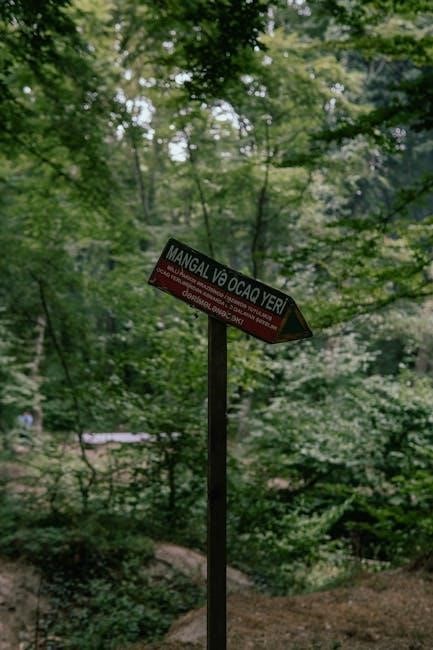The Pit in Diablo 4 is a challenging endgame feature designed to test players’ skills, gear, and strategy․ Community discussions highlight its difficulty spikes and one-shot mechanics, emphasizing the importance of preparation and optimization to progress through its levels successfully․
What is the Pit in Diablo 4?
The Pit is a challenging endgame feature in Diablo 4, designed to test players’ skills, gear, and strategy․ It involves navigating through multiple levels with increasing difficulty, requiring specific materials and preparation․ Players unlock the Pit by completing a high-level dungeon quest, gathering shards, and overcoming one-shot mechanics that emphasize skill over luck․ Community discussions highlight its difficulty spikes and the need for optimized builds and teamwork to progress through higher levels successfully․
Importance of the Pit in Diablo 4
The Pit in Diablo 4 serves as a benchmark for players to test their skills, gear, and strategic prowess․ It offers a unique endgame challenge, pushing players to optimize their builds and master mechanics․ Completing higher levels of the Pit rewards players with valuable materials and loot, making it a key activity for progression․ The Pit also fosters community engagement, as players share tips, strategies, and experiences, creating a shared challenge that enhances the game’s depth and replayability․
Overview of the Pit Mechanics
The Pit in Diablo 4 is a challenging timed event where players descend through increasingly difficult floors․ Each floor presents unique objectives, such as defeating enemies or destroying objects within a set time․ The Pit requires precise strategies and build optimization to progress․ Players must master their character’s skills and adapt to unpredictable enemy patterns․ The portal system allows access to higher floors, but success depends on efficiency and gear quality․ Shards are consumed to enter, adding a layer of resource management․ The Pit mechanics test both skill and preparation, making it a core endgame activity for dedicated players seeking a true challenge․

Understanding the Pit Mechanics
The Pit in Diablo 4 is a timed event where players progress through floors by completing objectives like defeating enemies or destroying objects quickly․ Each floor introduces new challenges, requiring strategic planning and efficient gameplay to succeed․
How the Pit is Designed
The Pit in Diablo 4 is designed as a procedurally generated dungeon system, offering unpredictable layouts and enemy combinations․ Each floor features escalating difficulty, with tighter spaces and tougher enemies․ The design emphasizes vertical progression, rewarding players for adapting strategies․ Environmental hazards and traps add layers of complexity, requiring careful navigation․ The Pit’s architecture encourages diverse playstyles, from stealthy approaches to aggressive clears․ Reward chests and hidden secrets incentivize exploration, while the timer creates pressure to balance speed and caution․ This design fosters a challenging yet engaging experience tailored to both solo and group play․
The Role of One-Shot Mechanics in the Pit
The Pit in Diablo 4 incorporates one-shot mechanics, where certain enemy attacks or traps can instantly defeat even high-level characters․ These mechanics are designed to test reflexes, positioning, and situational awareness․ Players must master dodging, blocking, and using defensive skills to survive․ One-shot mechanics emphasize the importance of skill over gear, as even the best equipment can’t save from a perfectly timed attack․ This system creates intense, high-stakes gameplay, pushing players to adapt and improve․ Properly managing these mechanics is crucial for progressing through the Pit’s higher levels, where the margin for error is razor-thin․
Luck vs․ Skill in the Pit
The Pit in Diablo 4 sparks debate about the role of luck versus skill․ While skillful play is essential for navigating its challenges, luck can influence outcomes, such as enemy spawn patterns or item drops․ Players must master mechanics and strategies to minimize reliance on luck․ However, even skilled players may face unpredictability, like rare enemy combinations or unfavorable itemization․ Ultimately, skill remains the primary driver of success, but luck can still shape experiences․ Balancing these elements keeps the Pit dynamic, rewarding preparation while introducing unpredictability that tests adaptability and patience․

Unlocking the Pit
The Pit is unlocked through specific in-game quests and requirements, offering a challenging endgame activity that tests players’ skills and preparation in Diablo 4․
Level Requirements for Accessing the Pit
To access the Pit in Diablo 4, players must reach a minimum level of 50․ This ensures they have the necessary skills and strength to handle its challenges․ While level 50 is the baseline, higher levels, such as 60 or above, are recommended for tackling tougher tiers․ Lower-level characters can still participate but may struggle significantly․ The game enforces this requirement to maintain balance and ensure players are adequately prepared․ Reaching these levels typically involves completing the campaign, side quests, and engaging in various activities to gain experience․ This system helps players progress smoothly into the Pit’s demanding environment․
The Quest to Unlock the Pit
The Pit is unlocked through a specific questline that becomes available after completing the main campaign․ Players must interact with an NPC in the Fractured Peaks region, initiating a chain of events․ The quest requires gathering three Shattered Riftstones, which can be found in rifts scattered across the world․ These rifts are hidden in dungeons or elite enemy areas, adding an extra layer of challenge․ Once the Riftstones are collected, players return to the quest giver to activate the Pit․ This process is a one-time unlock, granting permanent access to the Pit․ The quest is essential for progressing endgame content․
Obtaining Shards for the Pit
Shards are a critical resource for accessing the Pit, as they are required to open portals to higher levels․ Players can obtain Shards by completing Nephalem Rifts, defeating elite enemies, or participating in events․ Additionally, Shards can be purchased from vendors using Blood Shards, though this method is less efficient․ Higher difficulty levels increase the drop rate of Shards, making them more accessible as players progress․ Managing Shard inventory is essential, as they are consumed when opening portals․ Regularly farming Shards ensures consistent access to the Pit and its challenges․

Navigating the Pit
Navigating the Pit involves understanding its layered structure and progression system․ Players must utilize portals to move between levels, adapting strategies as difficulty increases․ Resource management and adaptability are key to overcoming challenges and progressing deeper into the Pit․
Understanding the Portal System

The portal system in the Pit is a network of gateways connecting different levels, enabling players to traverse the ever-changing layout․ Each level contains a portal that, when activated using Shards, unlocks access to deeper, more challenging sections․ Portals are essential for progression, as they create permanent pathways between levels, allowing players to revisit lower levels if needed․ The system ensures that players can strategically navigate the Pit’s infinite layers, adapting to increasing difficulty and resource requirements․ Mastery of the portal system is crucial for efficient exploration and maximizing rewards in the Pit’s depths․
Progression Through Pit Levels
Progression through the Pit levels is driven by completing challenges and defeating enemies to earn Shards, which are used to unlock higher levels․ Each level introduces increased difficulty, with stronger enemies and tougher mechanics․ Players must strategically use resources and abilities to overcome these challenges․ As players progress, the Pit’s procedural generation ensures a unique experience each time․ Shards are crucial for advancing, as they not only unlock portals but also contribute to overall progression․ Checkpoints are earned at certain levels, allowing players to respawn and continue their journey․ The Pit’s design encourages careful planning and resource management to reach deeper, more rewarding levels․
Key Materials Needed for the Pit
To tackle the Pit effectively, certain materials are essential․ Shards are the primary currency for unlocking higher levels and portals․ Pit Keys are required to initiate a Pit run, ensuring access to this challenging content․ Codex Pages can enhance gear, providing critical boosts for tougher levels․ Additionally, Health and Stamina Potions are vital for survival, especially in higher difficulties․ Platinum is needed for crafting and upgrading gear․ Lastly, Primordial Gear fragments can be used to create powerful items, aiding in progression through the Pit’s demanding levels․ These materials ensure players are well-prepared for the challenges ahead․

Strategies for High-Level Pits
Mastering high-level pits requires precise execution, optimal gearing, and coordinated teamplay․ Focus on perfect positioning, resource management, and pattern recognition to overcome intense challenges effectively․
Optimizing Gear for the Pit
Optimizing gear is crucial for tackling high-level pits in Diablo 4․ Prioritize stats like primary attribute, vitality, and resistance based on your build․ Ensure gear is upgraded through enchanting or socketing with gems for enhanced effectiveness․ Focus on acquiring legendary items with synergistic affixes that complement your skills․ Maintain a balance between offense and defense to survive one-shot mechanics․ Experiment with gear sets to find the optimal combination for your playstyle․ While gear is vital, skill and strategy remain equally important for success in the Pit․
Best Builds for Pit Clearance
For successful pit clearance in Diablo 4, specific builds excel due to their balance of damage, survivability, and mobility․ Necromancers shine with their summon-based builds, utilizing minions to absorb damage and control crowds․ Druids thrive with shapeshifting builds, blending offensive and defensive capabilities․ Sorcerers are favored for their elemental mastery, delivering high burst damage while maintaining range․ Each build requires careful optimization of skills, passives, and gear․ Focus on enhancing mobility and survivability, as these are critical for navigating the Pit’s challenging mechanics․ The right build paired with skill and strategy can significantly improve your success in higher-level pits․
Teamplay and Coordination in the Pit
Teamplay and coordination are essential for tackling the Pit’s higher levels, where synchronized actions can mean the difference between success and failure․ Players must communicate effectively, assigning roles like tanking, damage dealing, and crowd control․ Synergizing abilities, such as pairing a Necromancer’s summons with a Sorcerer’s area-of-effect spells, enhances overall efficiency․ Coordination ensures that players can manage one-shot mechanics and resource generation collectively․ A well-coordinated team can navigate the Pit’s challenges more effectively, making progression smoother and more rewarding․ Strong communication and strategic planning are vital for overcoming the Pit’s demanding environments․

Gear and Build Optimization
Optimizing gear and builds is crucial for Pit success․ Selecting gear that complements your build and optimizing stats ensures maximum efficiency in overcoming the Pit’s challenges․
Importance of Paragon Levels in the Pit
Paragon levels are essential for maximizing character potential in the Pit․ They provide critical stat boosts and powerful bonuses, enhancing damage output, survivability, and mobility․ As players progress, investing in the right Paragon nodes becomes vital for tackling higher-level Pits․ The system allows customization, enabling builds to focus on specific strengths, such as increased crit chance or improved resistance․ Reaching higher Paragon levels ensures characters remain competitive, especially in later stages where enemies are tougher and mechanics are more punishing․ Balancing Paragon point allocations is key to overcoming the Pit’s challenges effectively․
Upgrading Gear for the Pit
Upgrading gear is crucial for success in the Pit, as it directly impacts survivability and damage output․ Players can enhance their equipment through crafting or enchanting, using materials like Forgotten Souls or crafting recipes․ Prioritizing stats such as strength or intelligence based on class needs is key․ Upgrading weapon and armor slots significantly improves effectiveness against challenging mechanics and higher-level enemies․ Regular gear upgrades are essential to tackle increasing difficulty and maintain progress through the Pit’s demanding stages․
Fail Rates and Gear Upgrade Challenges
Fail rates in the Pit are heavily influenced by gear quality and enemy difficulty․ Upgrading gear is essential but challenging due to the scarcity of upgrade materials like Forgotten Souls or Echoes of the Abyss․ Crafting systems can be unpredictable, and failing to achieve desired stats resets progress, costing valuable resources․ Higher Pit levels exacerbate these challenges, as enemies become increasingly resilient․ Players must balance gear upgrades with resource management to minimize fail rates and maintain consistent progress through the Pit’s demanding stages․

Common Challenges in the Pit
The Pit presents significant hurdles, including unpredictable enemy patterns, resource depletion, and high damage spikes․ Players must adapt strategies to survive intense combat scenarios and progression barriers․
Difficulty Spikes in Higher Levels
In higher Pit levels, players face dramatic difficulty spikes due to enhanced enemy stats and complex attack patterns․ Enemy health and damage output escalate significantly, requiring precise reflexes and optimized builds․ These spikes often catch players off-guard, especially when encountering elite or boss-like enemies with devastating one-shot mechanics․ The challenge intensifies as resource management and dodge mechanics become critical to survival․ Mastery of class abilities and gear optimization are essential to overcome these spikes, making the Pit a true test of skill and preparation for even experienced players․
Managing Resources in the Pit
Managing resources in the Pit is crucial for sustained progress, especially in higher levels․ Health potions, offensive cooldowns, and defensive abilities must be used strategically to survive intense encounters․ Players should conserve potions for critical moments and time their ultimate abilities wisely to maximize damage output․ Resource management becomes more challenging as the difficulty increases, requiring careful planning to avoid unnecessary deaths․ Efficient use of cooldowns and abilities ensures longevity in prolonged fights, making it a key factor in overcoming the Pit’s daunting challenges․
Dealing with One-Shot Mechanics
One-shot mechanics in the Pit are deadly traps or abilities that can instantly kill even well-geared characters․ Surviving these requires precise awareness and positioning․ Players must learn enemy patterns and environmental hazards to avoid triggering these mechanics․ Timing dodges and using defensive skills is critical․ Understanding the tells of one-shot mechanics allows for better anticipation․ Practicing these sections repeatedly helps build muscle memory․ While challenging, mastering these mechanics is essential for progressing through higher Pit levels․ Balancing risk and reward is key to avoiding unnecessary deaths and maintaining progress in the Pit․

Community Insights and Tips
Players share strategies and tips for tackling the Pit, emphasizing teamwork, build optimization, and pattern recognition․ Community feedback highlights the importance of communication and coordination․
Reddit Discussions on Pit Mechanics
Reddit forums buzz with active discussions about the Pit, focusing on mechanics, strategies, and player experiences․ Many threads highlight the importance of understanding one-shot encounters and resource management․ Players share detailed analyses of enemy patterns, optimal build choices, and gear recommendations․ The community collaborates to identify efficient routes and techniques to minimize failure rates․ Topics like luck vs․ skill and the role of paragon levels frequently surface, sparking debates and fostering innovation among players․ These discussions serve as a hub for sharing tips, resources, and inspiration, proving invaluable for both new and seasoned adventurers aiming to conquer the Pit․
Player Experiences and Feedback
Players share diverse experiences with the Pit, ranging from frustration to accomplishment․ Many report initial struggles with one-shot mechanics, emphasizing the need for precise execution․ Casual players appreciate the challenge, while hardcore enthusiasts praise the depth of strategy required․ Feedback highlights the satisfaction of progressing through higher levels, despite the steep difficulty curve․ Common themes include the importance of optimized builds and teamwork․ Players also note the rewarding feeling of overcoming tough encounters, fostering a sense of community and shared achievement․ These experiences underscore the Pit’s design as a challenging yet engaging endgame activity․
Top Tips from Seasoned Players
Seasoned players recommend prioritizing gear optimization, focusing on high-tier affixes and balanced stats․ Mastering your build’s rotation and cooldown management is crucial for survival․ Practice mechanics in lower levels before tackling higher floors to build muscle memory․ Communicate with your team to coordinate strategies and execute boss mechanics flawlessly․ Stay mobile and avoid standing in harmful effects․ Use defensive skills proactively and conserve resources for critical moments․ Learn from each death to improve decision-making․ Lastly, stay patient and persistent, as consistent progression is key to conquering the Pit’s challenges․ These tips, shared by experienced players, can significantly enhance your Pit-clearing efficiency․

Endgame Considerations
The Pit’s endgame challenges demand refined strategies, focusing on maximizing Paragon levels and optimizing gear․ Players must adapt builds for sustained progression, balancing offense and defense effectively․
Pit Clearance and Endgame Progression
Clearing higher-level pits becomes a cornerstone of Diablo 4’s endgame, offering substantial rewards and progression opportunities․ Players must consistently refine their builds and strategies to overcome increasingly challenging levels․ The pit system encourages long-term engagement, with each cleared level unlocking access to more formidable challenges and superior loot․ Optimized gear, mastery of mechanics, and coordinated teamplay are essential for progressing deeper․ The endgame revolves around pushing pit levels, with each success enhancing character strength and preparing for even greater difficulties ahead․ This iterative process defines the late-game experience, rewarding dedication and skill with unparalleled growth and achievements․
Pushing the Limits of the Pit
Pushing the limits of the Pit in Diablo 4 demands mastery of its highest levels, where challenges escalate dramatically․ Players must embrace risk-and-reward strategies, as higher levels introduce devastating one-shot mechanics and intense resource management․ The ultimate goal is to reach the deepest, most punishing tiers, where only the most optimized builds and flawless execution prevail․ Rewards for such feats include elite legendary gear and bragging rights within the community․ To succeed, players must experiment with innovative builds, refine their playstyles, and collaborate with skilled teammates․ This pinnacle of endgame content tests dedication, creativity, and the boundaries of character potential․
Post-Pit Activities and Rewards
After conquering the Pit, players unlock exclusive rewards and activities that enhance their endgame experience․ Completing high-level Pit runs grants unique banners, titles, and legendary gear, symbolizing mastery and prestige․ These rewards often include rare crafting materials and recipes for powerful items․ Additionally, players can showcase their achievements on leaderboards, earning community recognition․ Post-Pit activities also provide access to special challenges and events, further testing skills and offering additional rewards․ These incentives drive continuous improvement and engagement, making the Pit a cornerstone of Diablo 4’s endgame progression and replayability․
The D4 Pit is the culmination of your endgame journey, pushing your skills to the limit․ Mastering its challenges brings immense satisfaction and rewards, making it an unforgettable experience․
Final Thoughts on the Pit
The Pit represents the pinnacle of Diablo 4’s endgame challenges, offering a rewarding yet brutal experience․ It tests skill, strategy, and gear optimization, making it a true test of mastery․ While the grind can be intense, the satisfaction of conquering higher levels is unmatched․ The Pit fosters a sense of community, as players share strategies and learn from one another․ For dedicated players, the Pit becomes more than just a challenge—it’s a way to push limits and define their legacy in Sanctuary․ Its design ensures endless progression, making it a cornerstone of Diablo 4’s long-term appeal․
Future Updates and Improvements
Blizzard has hinted at ongoing support for the Pit, with plans to introduce seasonal content updates․ These updates may include new mechanics, increased difficulty levels, or unique rewards to keep the challenge fresh․ Balance changes for classes and gear are also expected to ensure fairness and diversity in playstyles․ Quality-of-life improvements, such as better resource management or more accessible shard farming, could be implemented based on community feedback․ The Pit’s success will likely lead to expansions, offering players new ways to test their skills and progress․ Regular updates will ensure the Pit remains a dynamic and engaging part of Diablo 4’s endgame․
